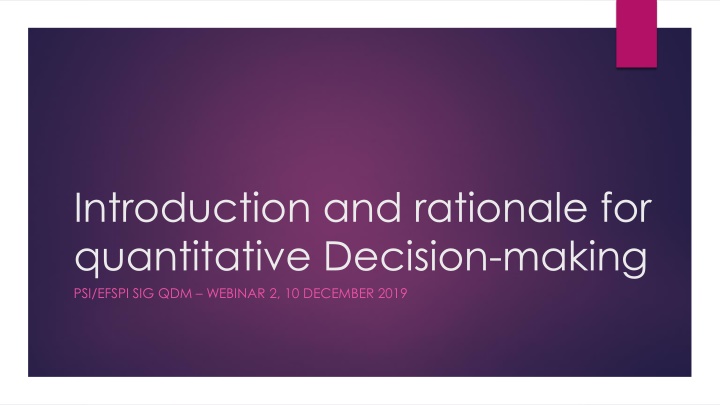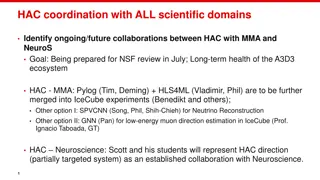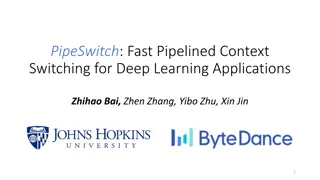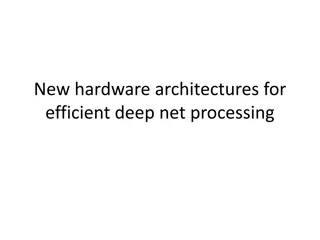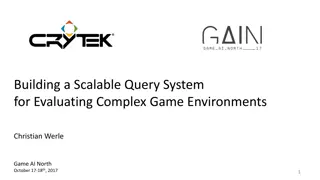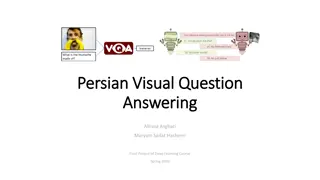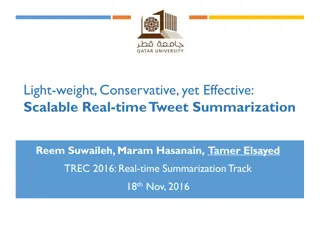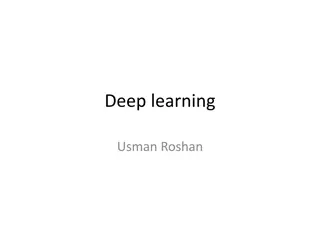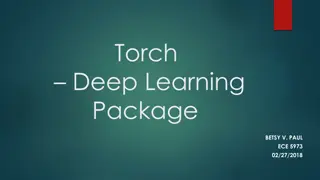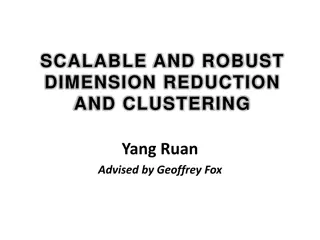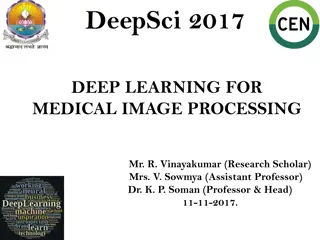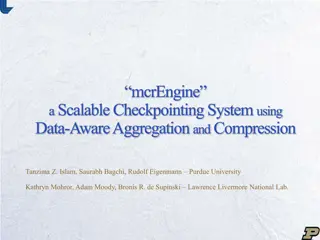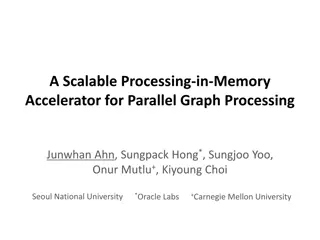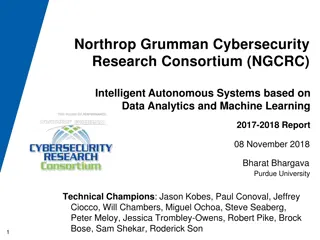Efficient and Scalable Deep Learning System
Developments in deep learning training systems, as presented in "Project Adam: Building an Efficient and Scalable Deep Learning Training System" by Trishul Chilimbi and team from Microsoft Research. The project optimizes computational and communication balance, achieving high performance and scalability through system co-design. Addressing challenges in deep learning like computational needs and model size impact on accuracy, the project focuses on neural network training methods like convolutional neural networks with the aim of enhancing overall efficiency.
Download Presentation

Please find below an Image/Link to download the presentation.
The content on the website is provided AS IS for your information and personal use only. It may not be sold, licensed, or shared on other websites without obtaining consent from the author.If you encounter any issues during the download, it is possible that the publisher has removed the file from their server.
You are allowed to download the files provided on this website for personal or commercial use, subject to the condition that they are used lawfully. All files are the property of their respective owners.
The content on the website is provided AS IS for your information and personal use only. It may not be sold, licensed, or shared on other websites without obtaining consent from the author.
E N D
Presentation Transcript
Introduction and rationale for quantitative Decision-making PSI/EFSPI SIG QDM WEBINAR 2, 10 DECEMBER 2019
2 What are quantitative decision- making? Any quantitative criteria of interest to support decisions in drug development Summarize available information in quantitative terms to support an optimal and informed choice Can be used to assess Drug efficacy & toxicity (benefit-risk balance) Duration/costs of drug development Likelihood of a successful project Portfolio balance PSI Webinar - Quantitative Decision-Making PSI/EFSPI SIG QDM, 10 DECEMBER 2019
3 Why using quantitative decision-making tools? To improve the decision-making in drug development To provide a common transparent framework for decision-making for all clinical projects Using objective criteria To support complex decision rules combining multiple criteria (drug efficacy, drug toxicity, likelihood of success, time, project priority,...) To take advantage of various prediction tools To deal with uncertainty by making sound predictions PSI Webinar - Quantitative Decision-Making PSI/EFSPI SIG QDM, 10 DECEMBER 2019
4 When are quantitative decision-making tools useful? Before a clinical study to optimize the study design During a clinical study, when design modifications are required or interesting After a clinical study to support the future drug development E.g. to select the best drug/dose/population To support a Go/noGo decision at various steps of the clinical development and add uses at the portfolio level PSI Webinar - Quantitative Decision-Making PSI/EFSPI SIG QDM, 10 DECEMBER 2019
5 Decisions to be made in various situations Study level: any decision that have an impact on a current clinical trial (Is an adaptive design useful? What are the advantages of an early stopping rule for futility? What are the recruitment projections). Development level: any decision that have an impact on the development plan or an upcoming clinical trial (number of clinical trials, Go/no-Go decisions, Due diligence). Portfolio level: any decision that have an impact on the portfolio management (financial resource allocation, selection of development projects, return-on-investment evaluation ) PSI Webinar - Quantitative Decision-Making PSI/EFSPI SIG QDM, 10 DECEMBER 2019
6 Example at Study level (1/3) A clinical study comparing a new drug and a placebo What if we make a go/no-go decision at the end of the study? The drug is Effective Ineffective No-Go Wrong decision Correct decision Go Correct decision Wrong decision PSI Webinar - Quantitative Decision-Making PSI/EFSPI SIG QDM, 10 DECEMBER 2019
7 Example at Study level (2/3) The drug is Effective Ineffective A clinical study comparing a new drug and a placebo You decide to stop for futility Missed opportunity Great, you saved time and patients! Half of patients already treated and observed at an interim analysis Is the drug really efficient? What if we were just lucky? You decide to continue the current study You decide to continue to the next study No gain, No cost No gain, What is the probability to get a successful clinical study? waste of resources You wasted time and patients Can we stop the clinical study right now? Great,you accelerated the development What if we make a go/no-go decision at the interim? Spiegelhalter et al. 2004. O Hagan et al. 2005. Gasparini et al. 2013 PSI Webinar - Quantitative Decision-Making PSI/EFSPI SIG QDM, 10 DECEMBER 2019
8 Example at Study level (3/3) 1.0 Power PrSS Drug effect Is the drug really efficient? What if we were just lucky? What is the probability to get a successful clinical study? 0.8 Power / PrSS 0.6 0.4 0.2 0.0 0.0 0.5 True treatment effect 1.0 1.5 2.0 Spiegelhalter et al. 2004. O Hagan et al. 2005. Gasparini et al. 2013 PSI Webinar - Quantitative Decision-Making PSI/EFSPI SIG QDM, 10 DECEMBER 2019
9 Example at Development level (1/2) Can we accelerate the clinical development by recruiting less patients? 1.0 0.8 Power / PrSS 0.6 Saving time, but with a higher risk of failure! 0.4 The probability of success will decrease with a lower sample size Power PrSS 0.2 0.0 0 100 200 300 400 500 Sample size per group PSI Webinar - Quantitative Decision-Making PSI/EFSPI SIG QDM, 10 DECEMBER 2019
10 Example at Development level (2/2) PoC study Go/noGo decision PoC study Go/noGo decision Can we jump from a PoC study to the Phase III study? 40% 40% Save time But we may not have the optimal dose Phase II study select the optimal dose, leading to a more successful Phase III Phase II study Select the optimal dose We need a compromise between saving time and a good probability of success 70% Phase III study Prove superiority of our drug Overall success 25% Phase III study Prove superiority of our drug Overall success 20% 90% 50% Normally distributed data, assuming common known variance for the two groups PSI Webinar - Quantitative Decision-Making PSI/EFSPI SIG QDM, 10 DECEMBER 2019
11 Example at Portfolio level Example of a current portfolio Preclinical Phase I PoC Phase II Phase III Submission Paul et al Nat Rev Drug Number of compounds Discov 2010 55 22 19 11 3 1 What is the probability of having at least 3 successful drug approbations (see Paul et al 2010)? When can we expect these drug approbations? Do we have enough projects in Phase I to feed the portfolio in the next 5 years? Is the expected benefit higher than the planned development costs? Paul, S., Mytelka, D., Dunwiddie, C. et al. How to improve R&D productivity: the pharmaceutical industry's grand challenge. Nat Rev Drug Discov 9, 203 214 (2010) doi:10.1038/nrd3078 PSI Webinar - Quantitative Decision-Making PSI/EFSPI SIG QDM, 10 DECEMBER 2019
12 Conclusion Various decisions to be made, pre-specifying quantitative criteria is important Statistical methods permit to quantify uncertainty Uncertainty decreases over the drug development Quantitative tools are intended to support but not to replace the human decision-making process for strategic decisions This is a team effort The statistician can properly evaluate a study design or a development strategy, but... The clinician or decision-maker define what really is a study success, what would be an interesting development strategy, what risk level seems acceptable Many quantitative methods exist but still remain unknown or unused PSI Webinar - Quantitative Decision-Making PSI/EFSPI SIG QDM, 10 DECEMBER 2019
